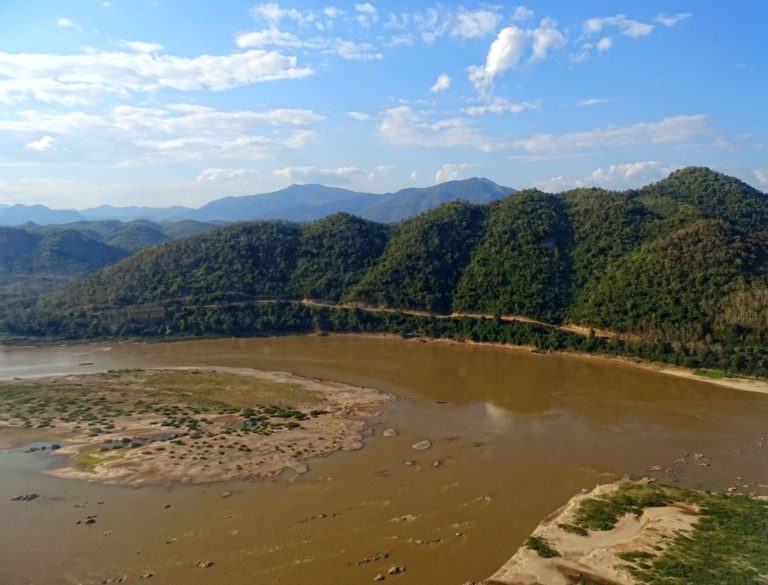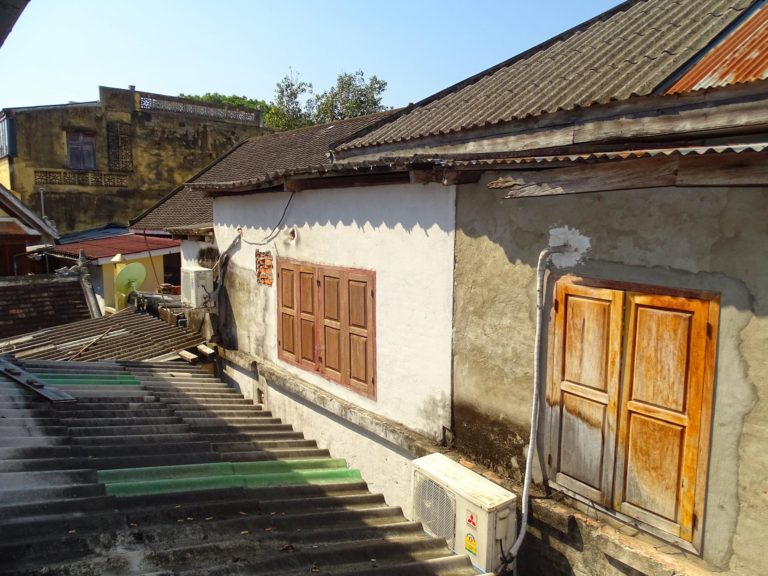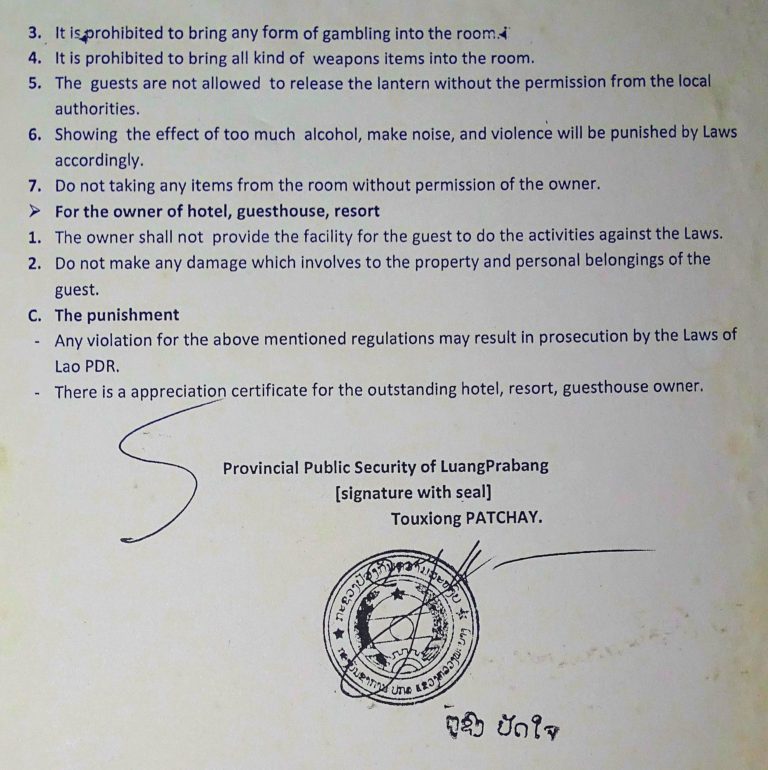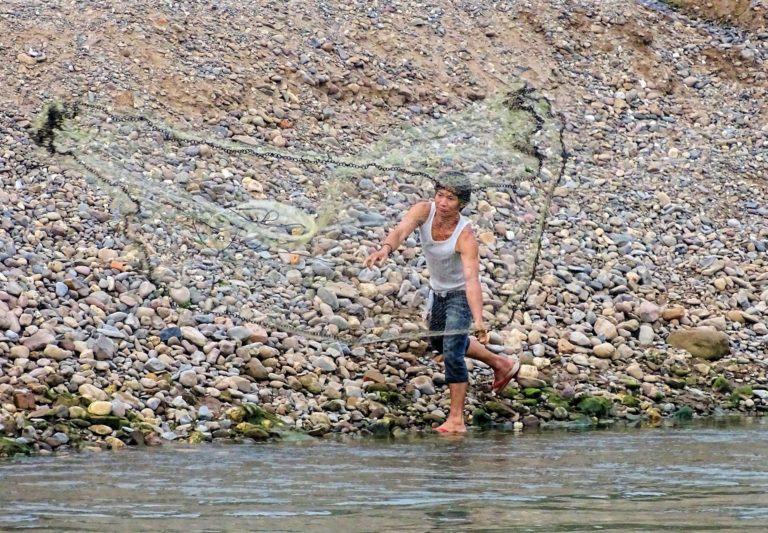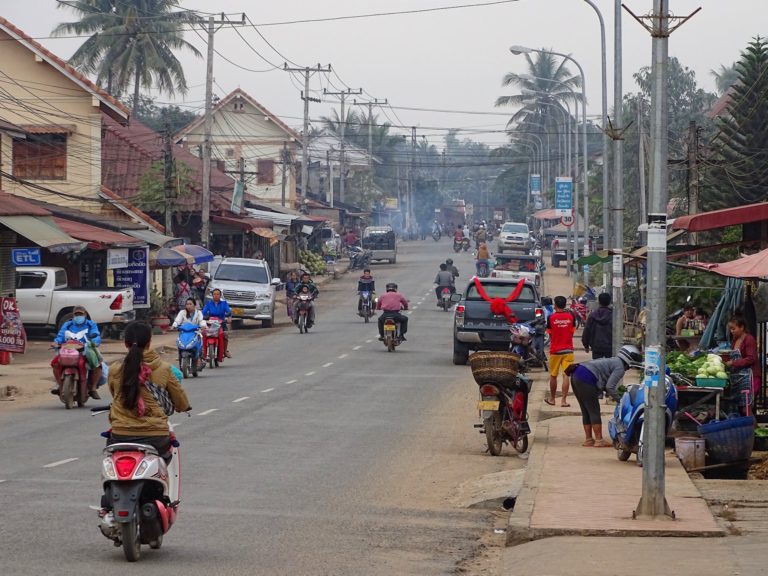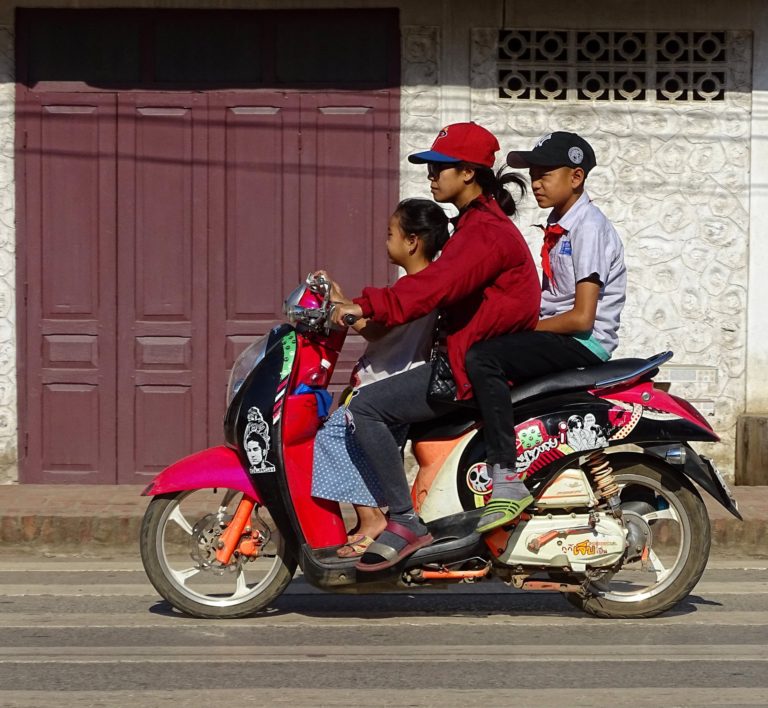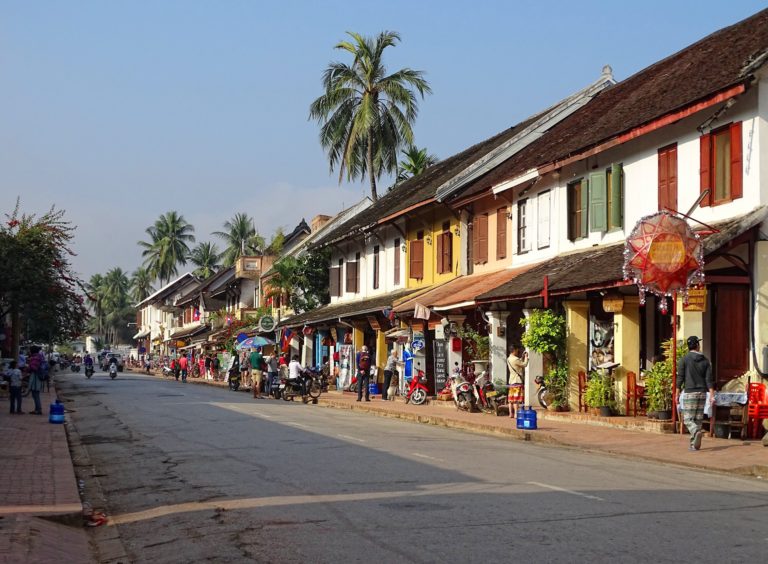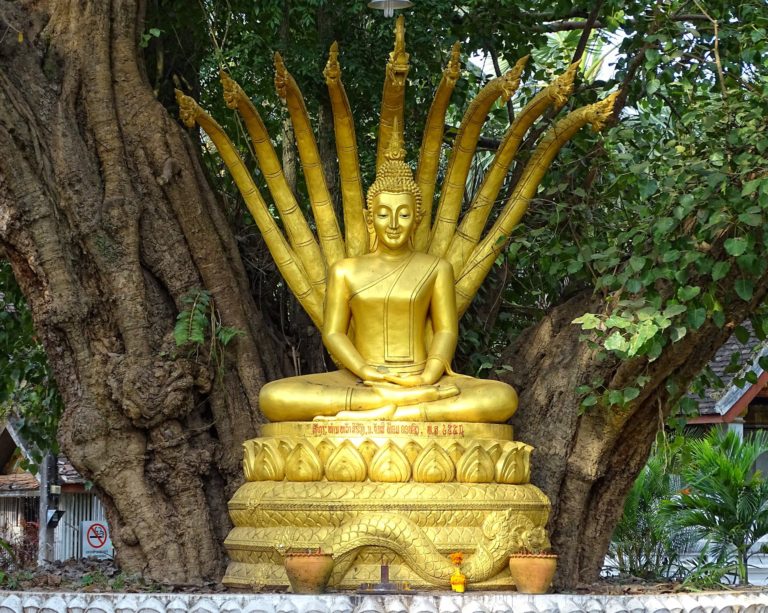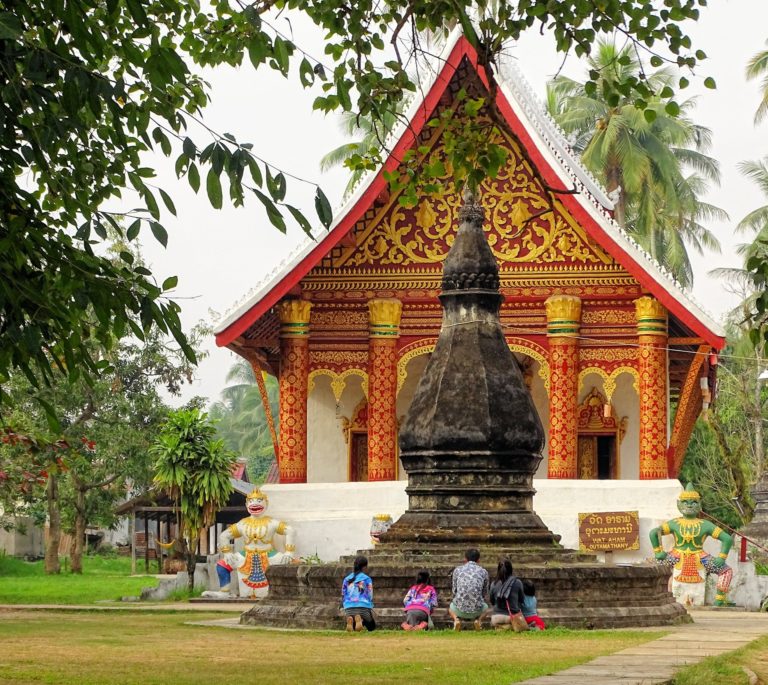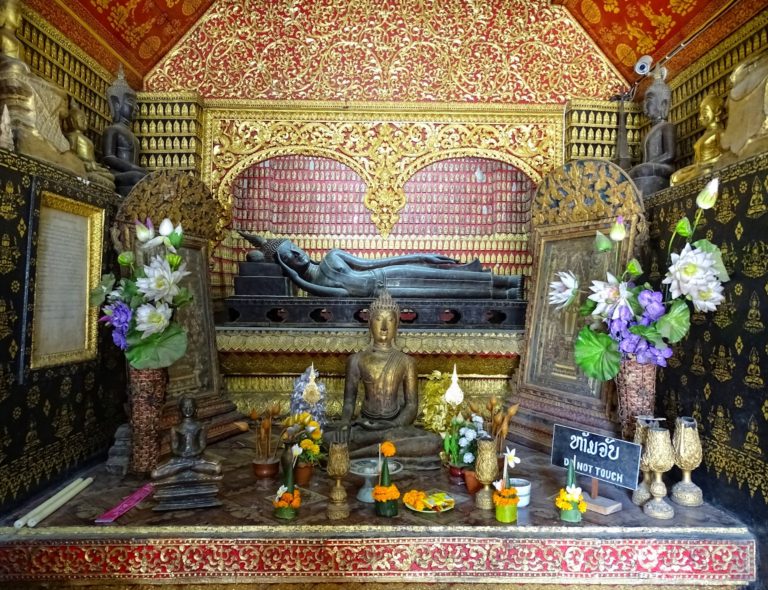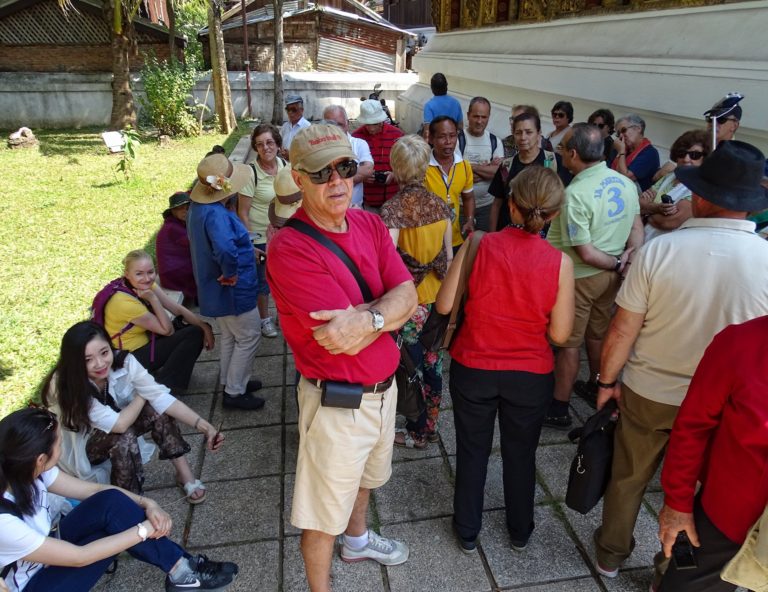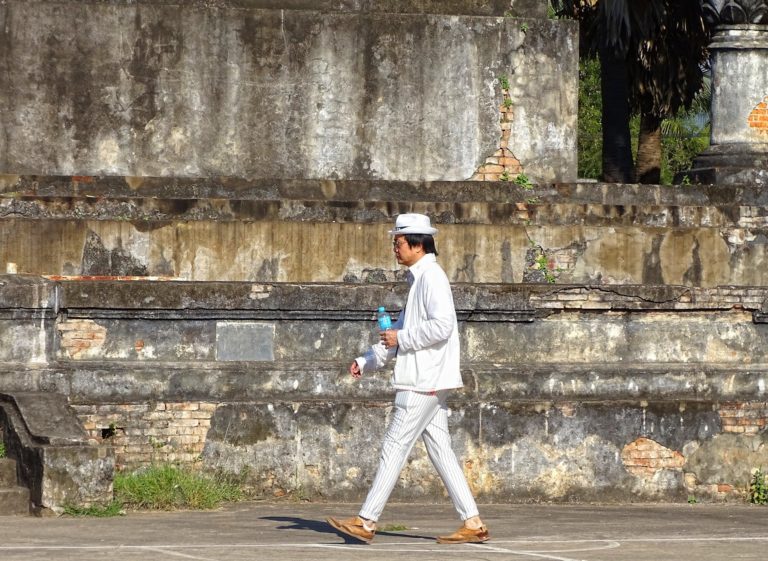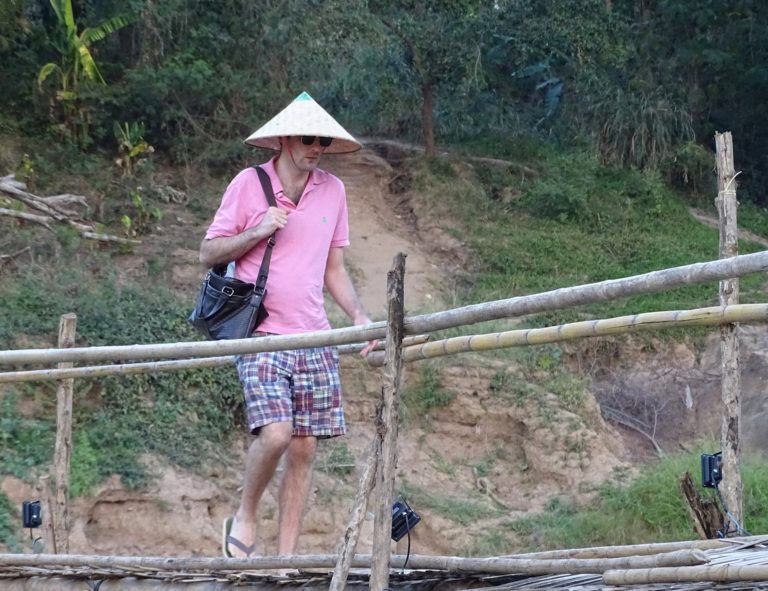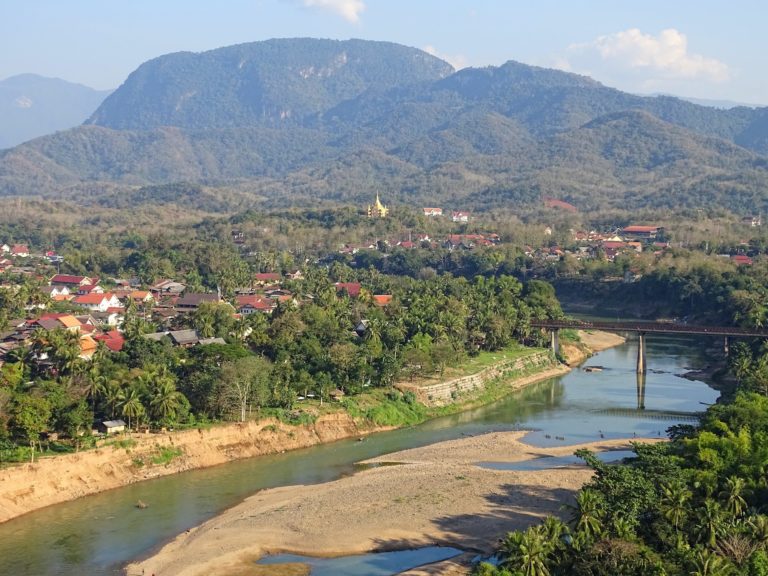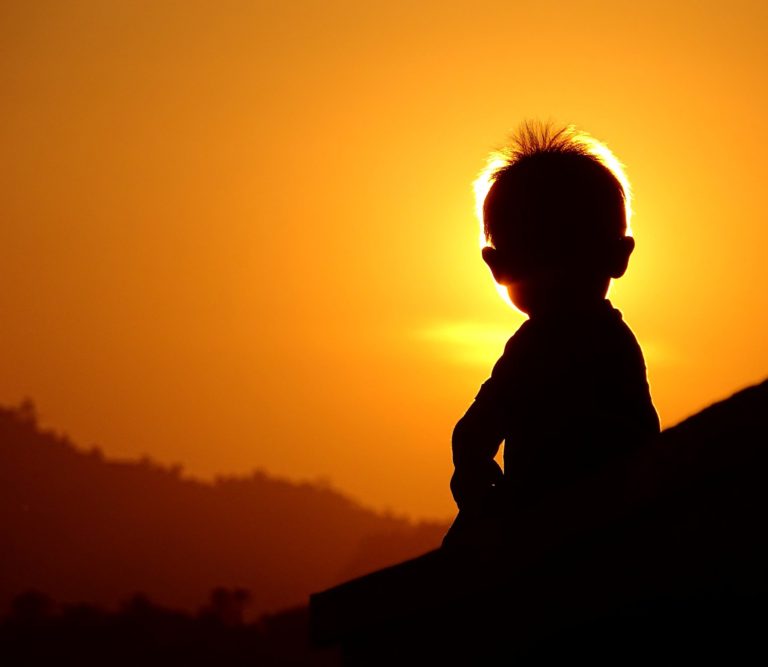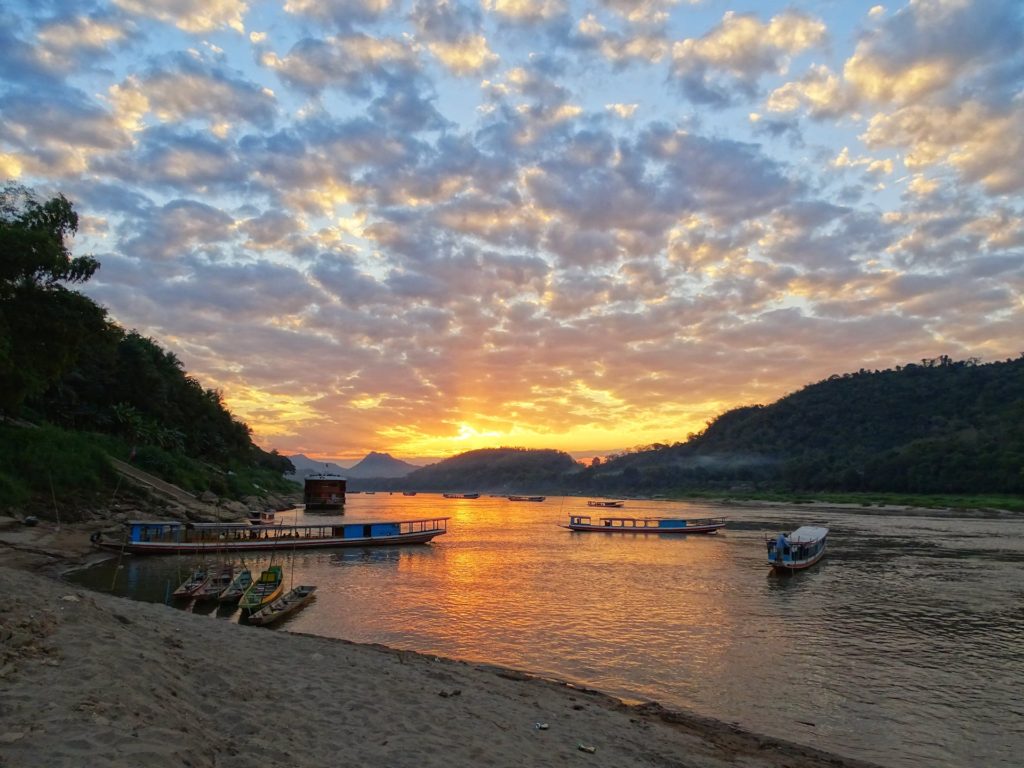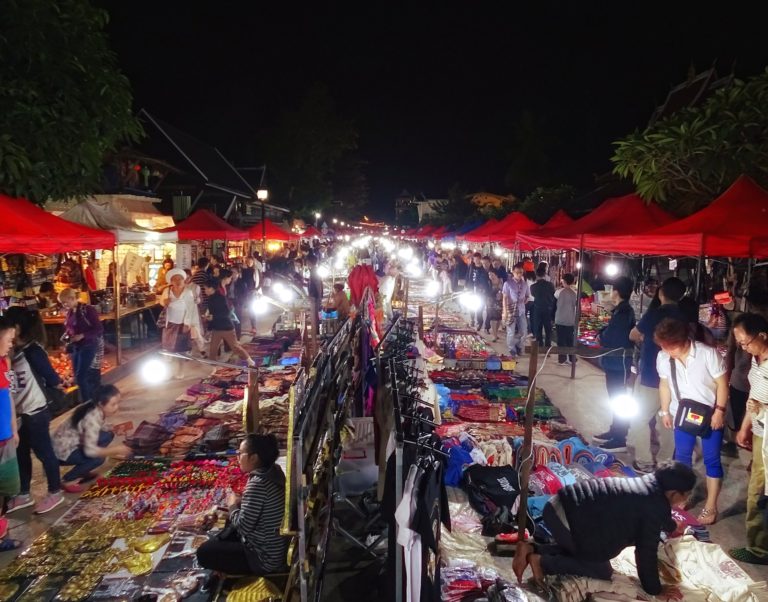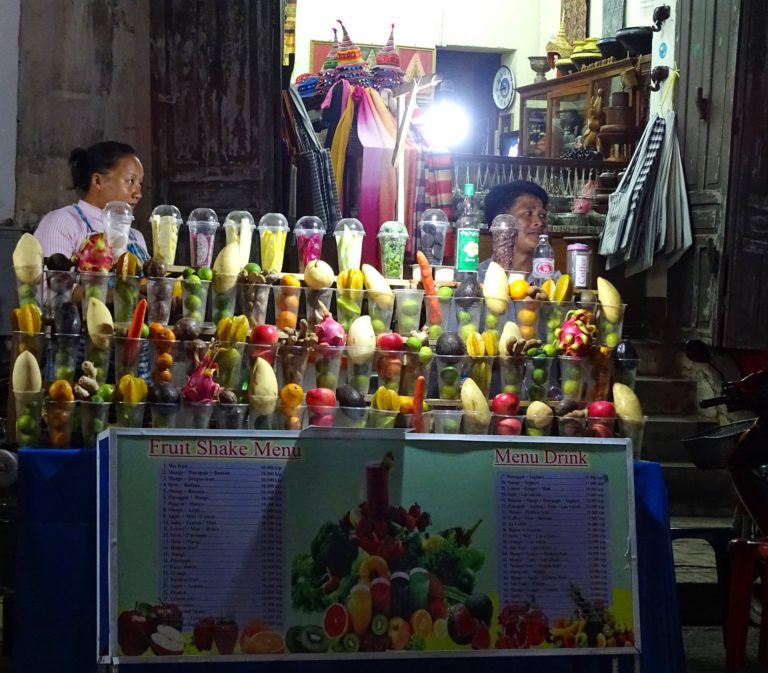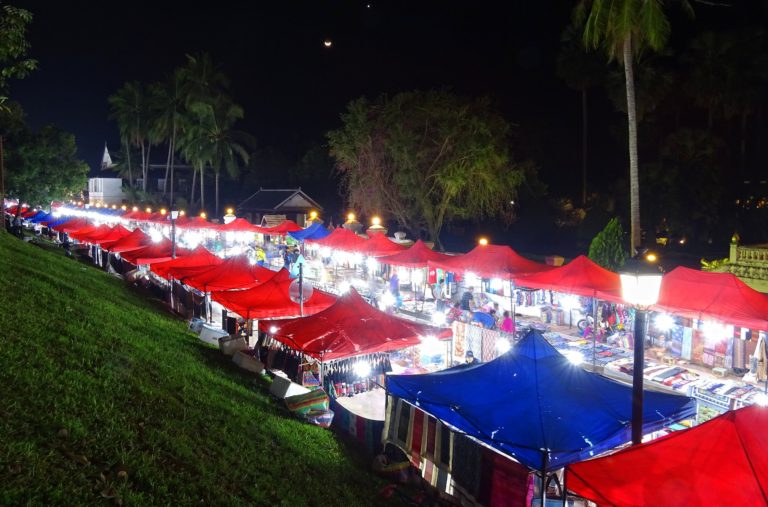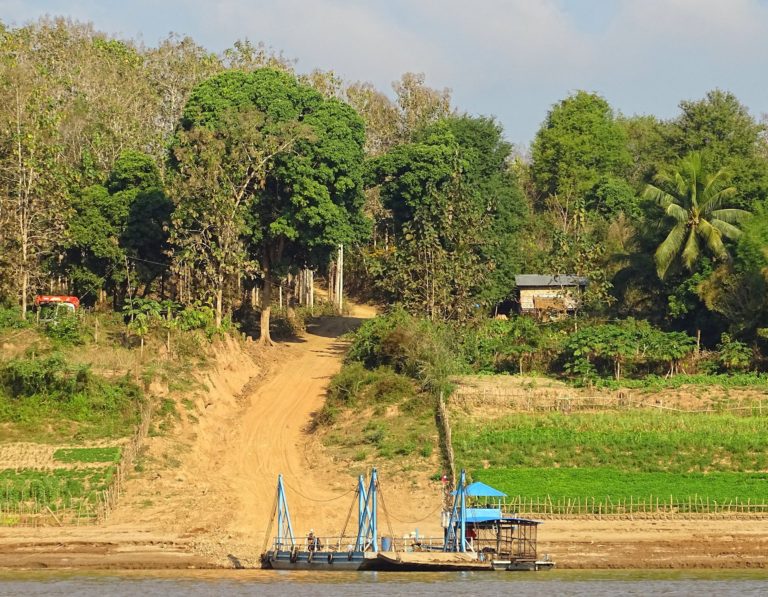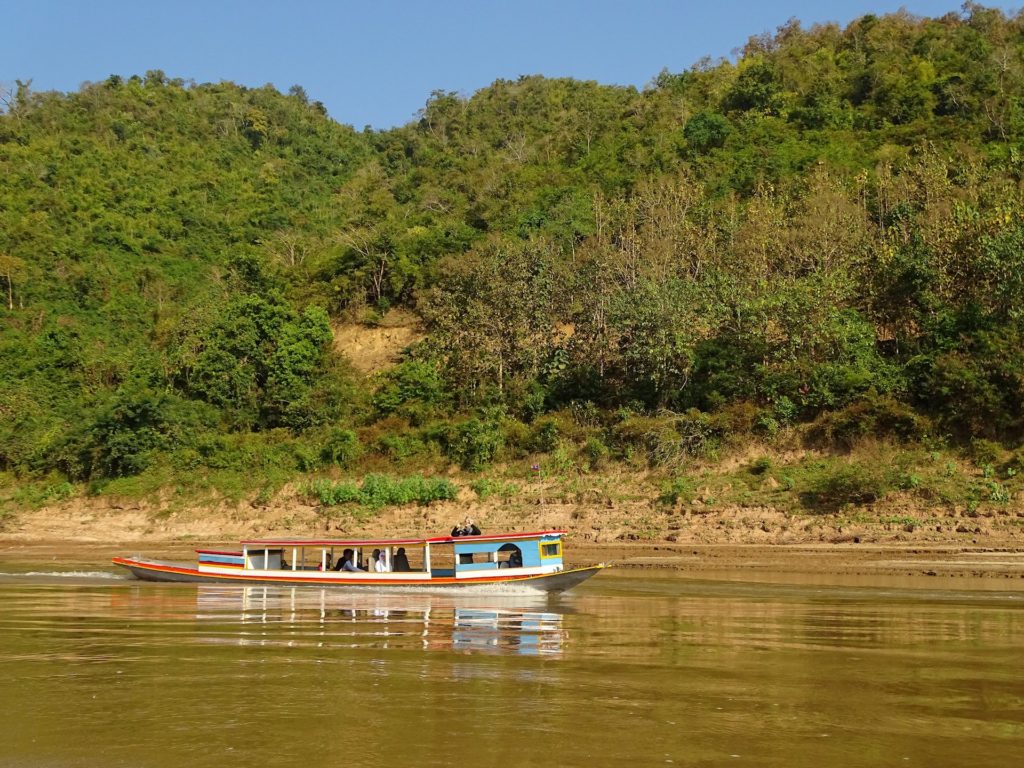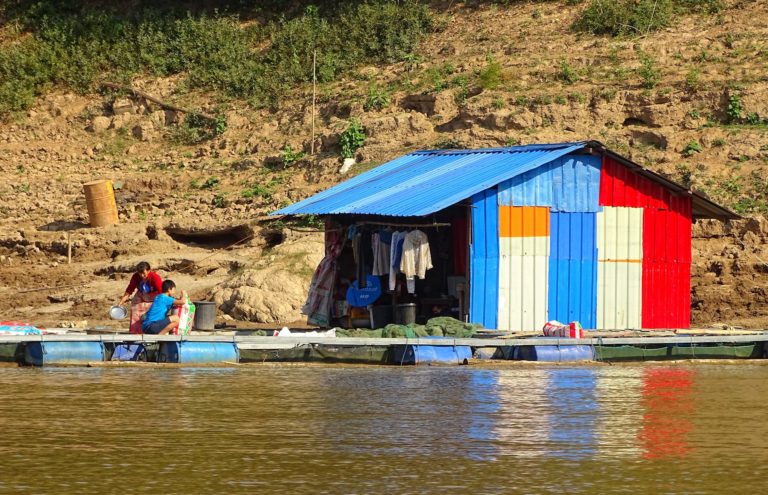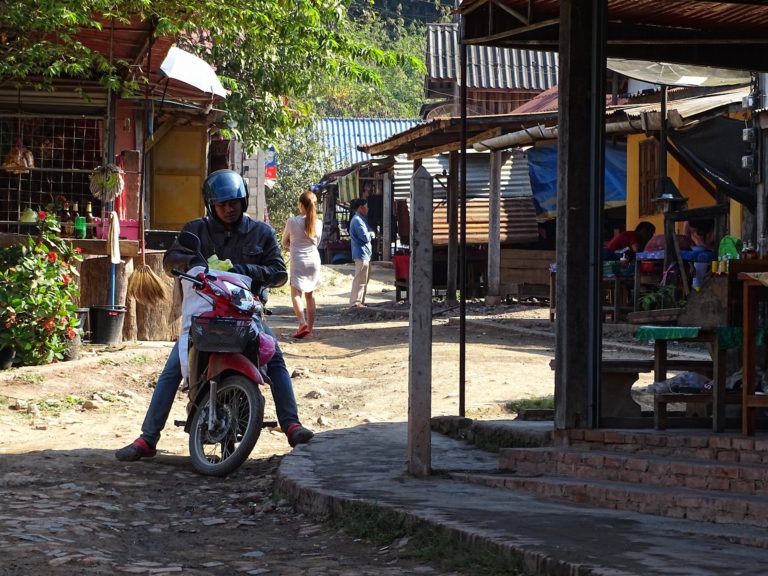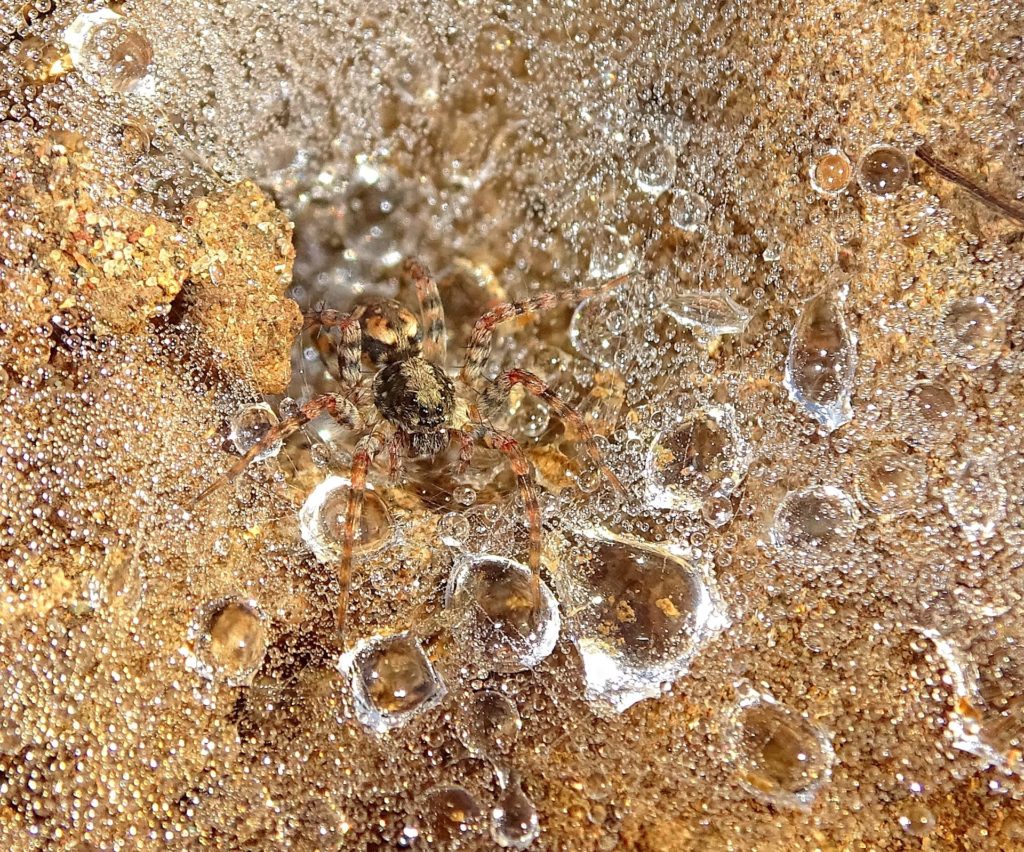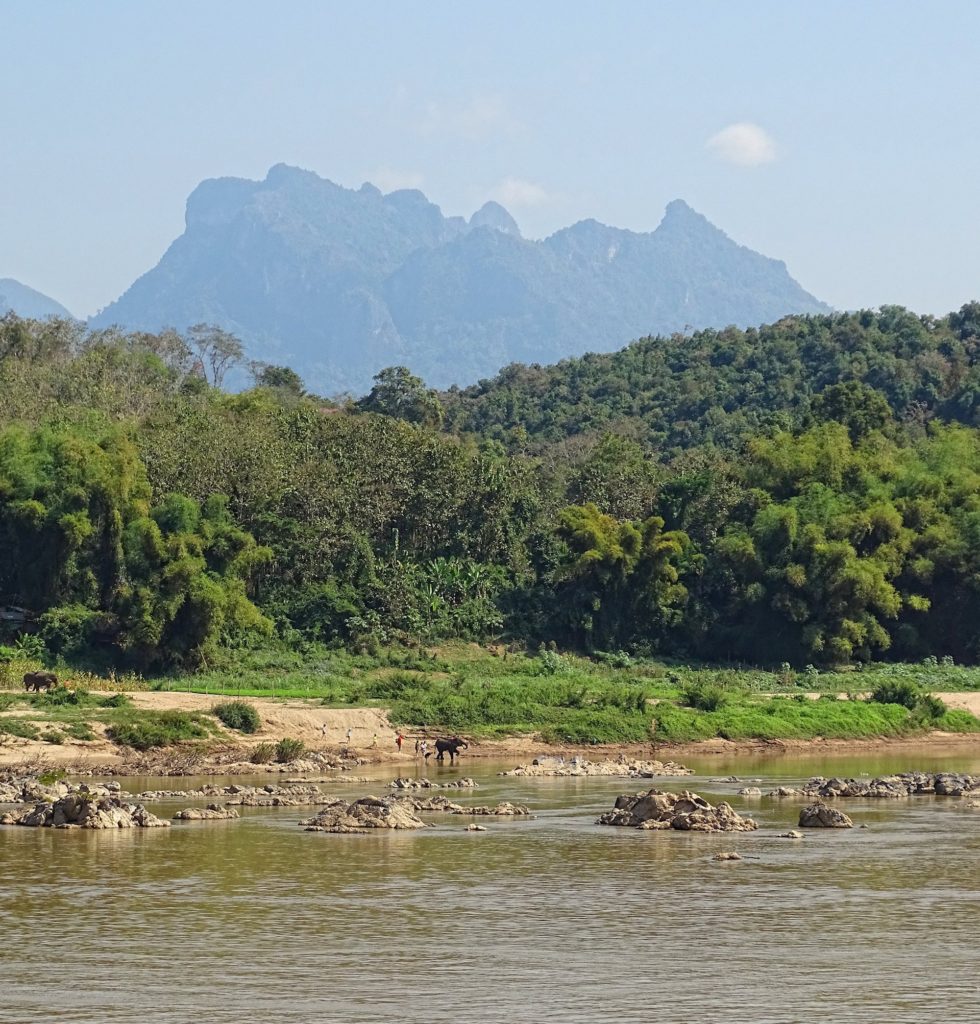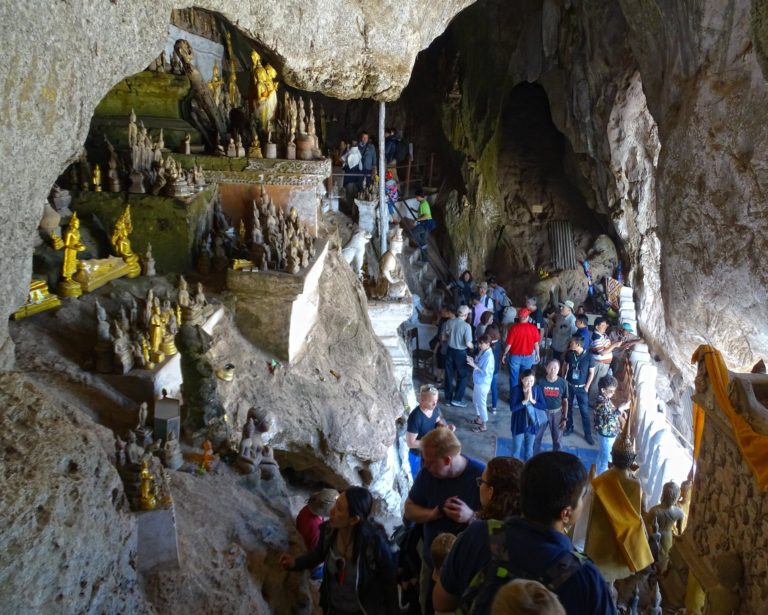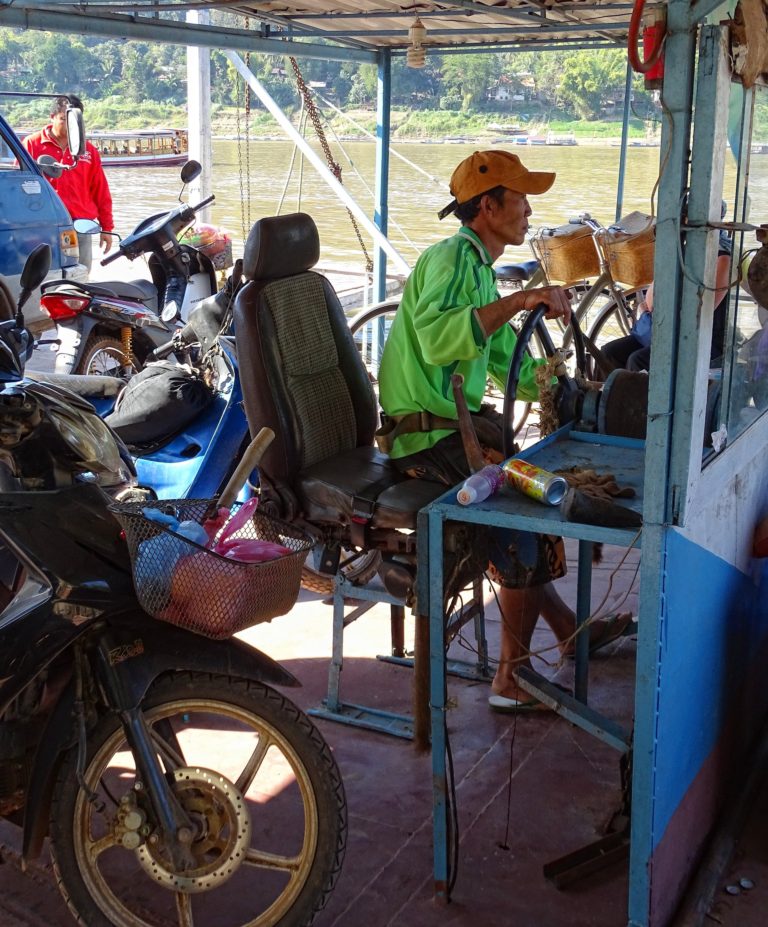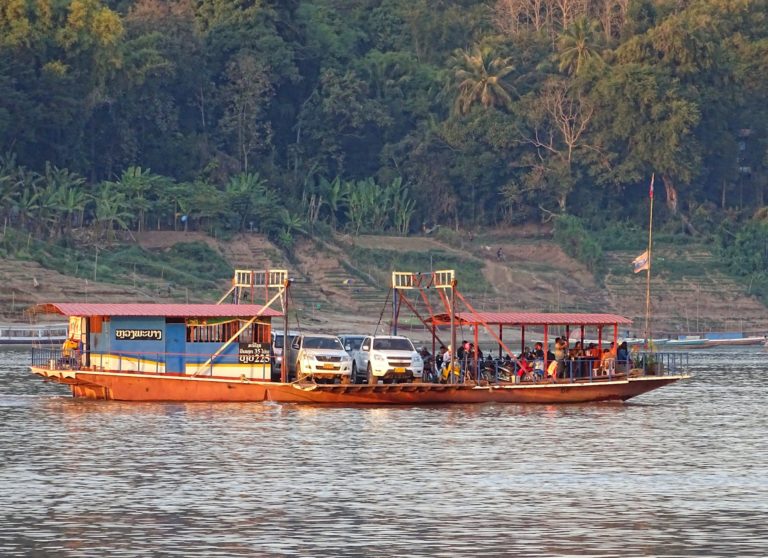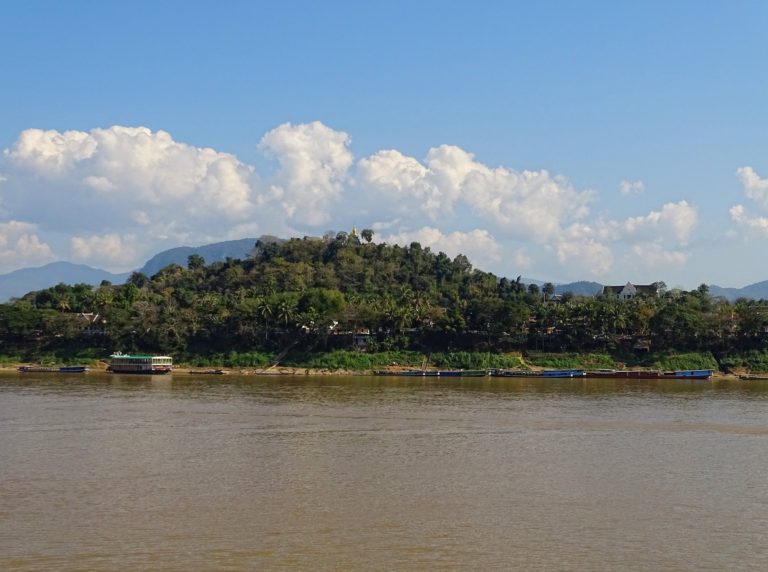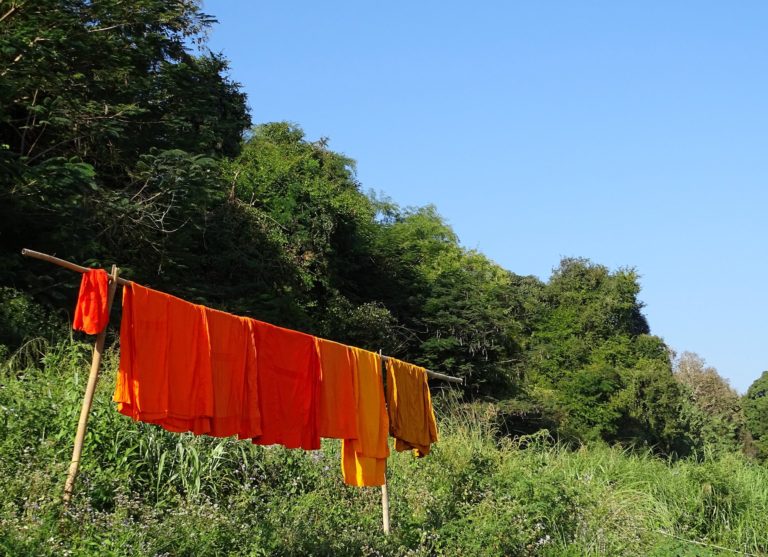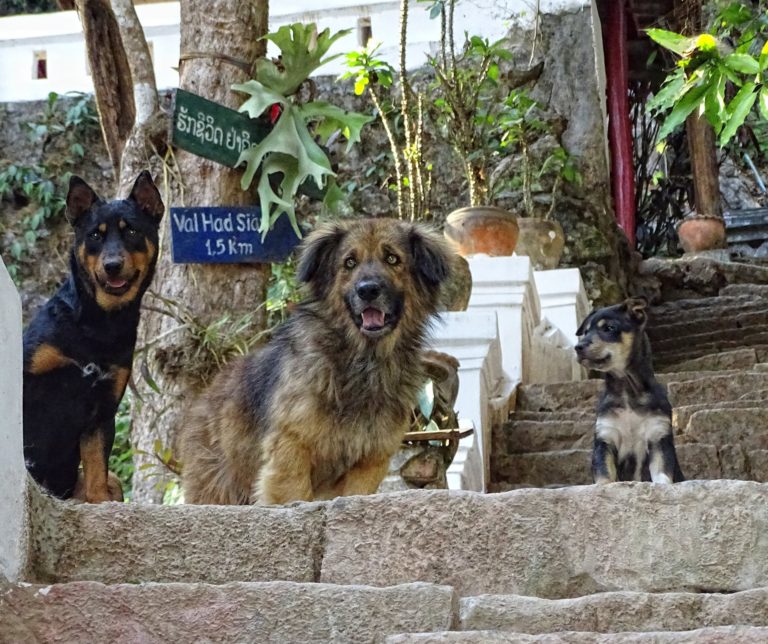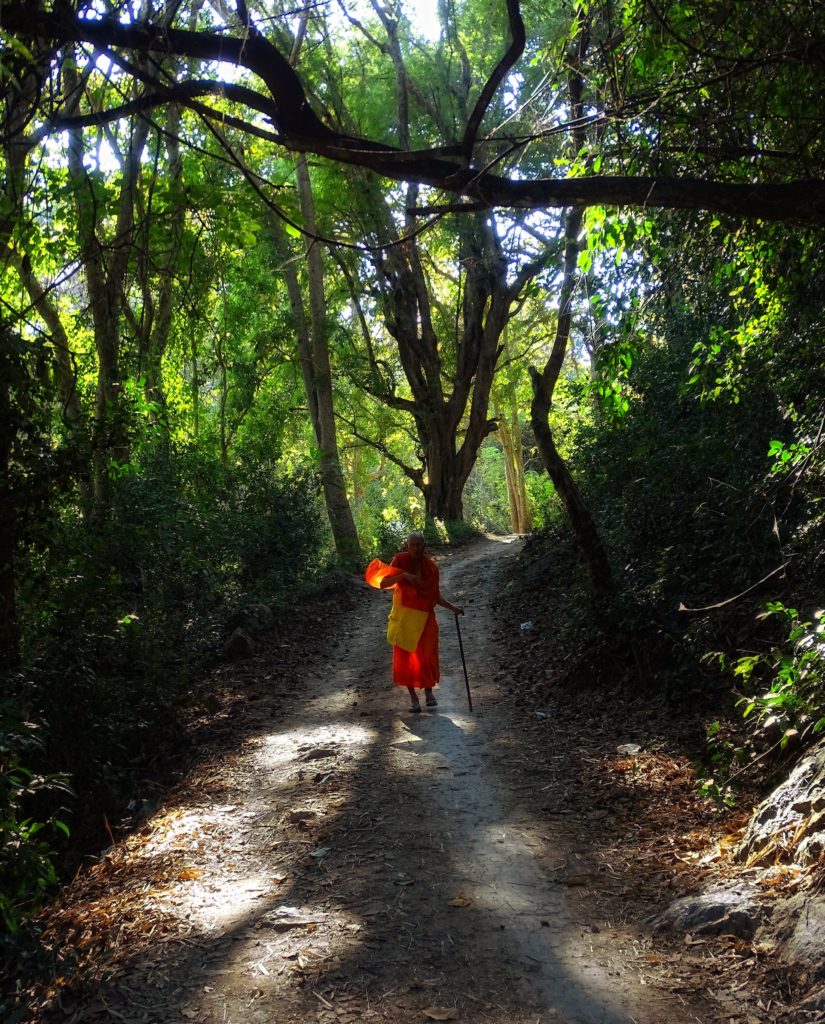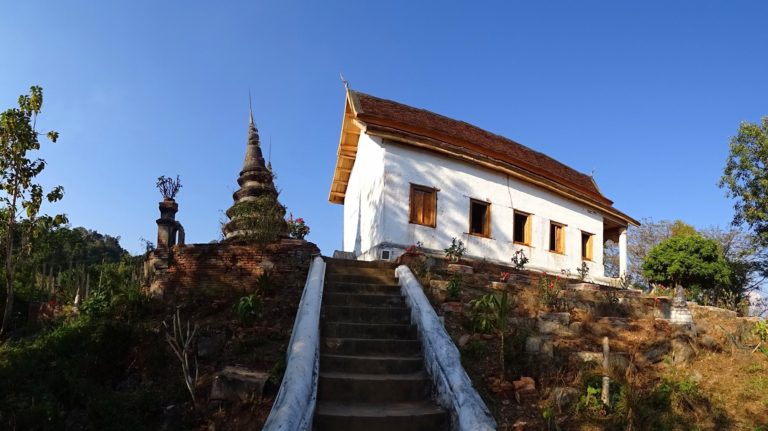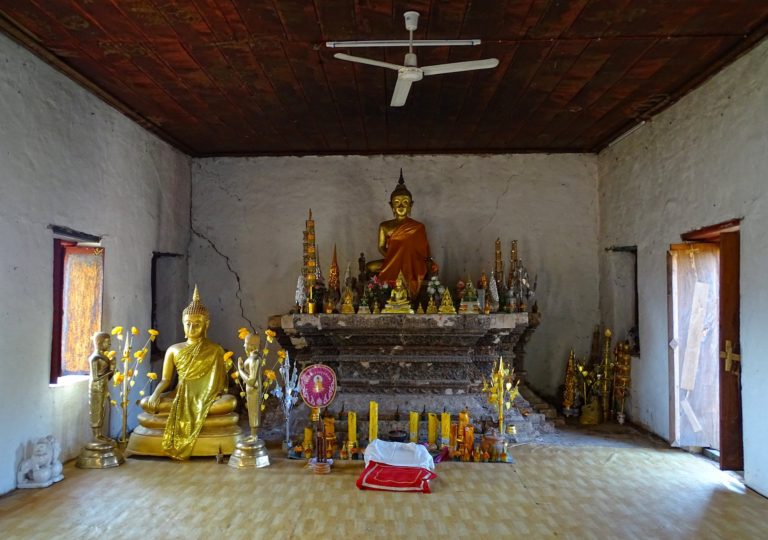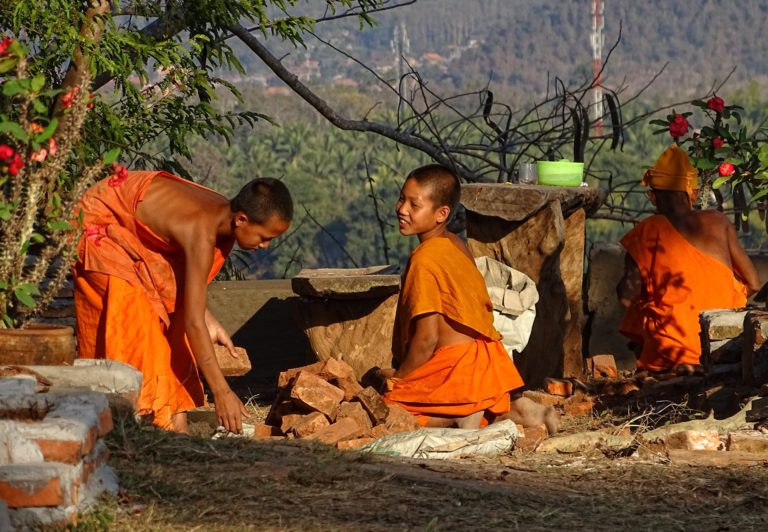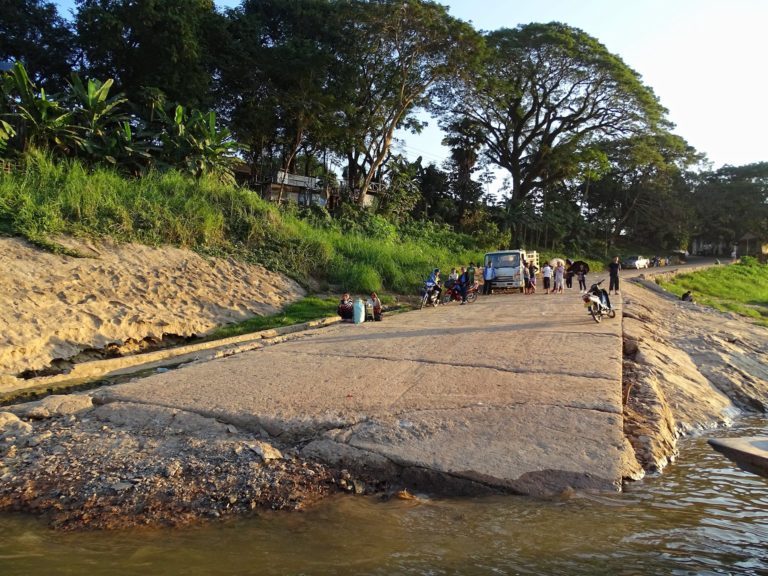Laos is famous among travelers as that funny country where you can go tubing on a river and get stupidly drunk for cheap. Fortunately, there are other and better sides to Laos.
A good reason for visiting Laos is the city Luang Prabang. It feels like a village, but has been the capital at various times throughout history. The result is a fascinating UNESCO World Heritage Site, a mix of traditional Lao traditional architecture, French colonial buildings and a huge number of Buddhist monasteries. An express train service coming in from China is under construction, so much of the charm of Luang Prabang is likely to soon disappear forever. Let’s go!
Our last stop was at Inle Lake, Myanmar, only 500 kilometers away. Between Inle and Luang Prabang lies the infamous opium-producing “Golden Triangle”. For safety reasons, tourists are not allowed to travel in that region. Instead, we travel 2,000 kilometers by bus and plane via Bangkok.
As we cross into Laos, the world below us becomes mountainous. The population density here is only a fifth of Thailand’s, and it shows.
Eventually the landscape opens up a bit. The Mekong runs between the hills of Laos, along a route that this river has spent a long time deciding on.
In Luang Prabang we discover that our timing is terrible. This week is Chinese New Year, which means that the town is swarming with the most ruthless of tourists. After a lengthy search, we manage to find a place to stay. Here you see the lovely view from our impossible-to-close window.
Sokdee Guesthouse is possibly the worst place I have ever stayed at, but we have no choice. It’s our own fault for coming to Luang Prabang at a bad time. Still, let me just take a moment to instruct you to never ever stay at the Sok Dee Guesthouse. That is, unless you’re a big fan of bed bugs, electrical shocks in the shower, dirty everything, and locked doors between ten in the evening and six in the morning. If you are, you’ll love it here. The rest of you; find somewhere else.
I love Sok Dee’s random listing of house rules, though. Especially the part with rules for the owners.
Enough about that. Let’s go for a morning walk.
A main attraction in Luang Prabang is the alms ceremony. Every morning, hundreds of monks walk in processions through the streets, accepting food offered by the locals.
I’m sure that not too long ago it was a nice tradition. These days it’s just a sad sight. Tourists crowd the most popular routes and treat the monks like a freak show. They get in their way, take close-up photos with flash, and generally behave with no respect.
There’s of course a lot of complaining about this, including the monasteries threatening to stop the whole thing. The government, however, knows that this “show” is part of what draws tourists to Luang Prabang, so they force the monasteries to keep it going.
Hence I made it a point to not seek out the “monk parade”. Still, on my walk well outside the tourist ghetto, I suddenly see a group of monks collecting their daily rice from some women who respectfully avoid making eye contact with the monks. I’m the only tourist around, at a distance, with a good zoom lens, hopefully not bothering anyone.
Down by the river I see a man picking up his breakfast. Net shopping is different when you don’t have wifi.
Much of Luang Prabang is just like the rest of South-East Asia, just less busy than the larger cities. Most people get around by scooter.
The average number of people per scooter is significantly higher than 1.
The old part of town is cozy and with not so much traffic. Many buildings were built in European style back when this region was part of French Indochina. Most of the buildings are well maintained, these days functioning as shops and restaurants catering mainly to grey-haired tourists carrying foreign currencies.
We see a lot of these. It’s a Nāga, a nine-headed king cobra that shelters the Buddha from all kinds of dangers.
According to Lao mythology, these benevolent creatures live in large numbers around the Mekong. Sadly, we only get to see the statue version.
We also sadly see two lions guarding a pagoda. Some sculptors have no respect for this majestic big cat.
A family is praying at Wat Aham. I’m not a fan of religion, but I find Buddhism to be one of the least silly ones. They also have the coolest sculptures, including awesome monsters and sometimes even quite graphic madonnas with big boobies.
Haw Pha Bang is a beautiful temple located in a corner of the park that also houses the Royal Palace. In 1975 the communists kicked the royal family out of here. Since then it has been a museum. No cameras allowed inside, unfortunately.
Further east on the peninsular old town we find Wat Xieng Thong, a major reason for why Luang Prabang received World Heritage status. Every building here contains one or more golden treasures in the shape of the Buddha. It may look like a most holy site, but it hardly feels like one.
We’re constantly surrounded by large tourist groups. Especially in the shade. Most visitors just stand around in the warm weather, ignore where they are, and instead concentrate on avoiding suffering a heat stroke while waiting for the next meal.
Thanks to the hundreds of tour buses coming in from China this week, the tourists are a lot harder to ignore than usual. Again, if you have a choice, avoid visiting during this time of the year.
It turns out that also the Chinese in Luang Prabang are quickly picking up the tourist habit of dressing silly.
Yet there’s no doubt that we westerners are still the masters of the art.
Just before the confluence between the Nam Khan river and the Mekong, an entrepreneur built this bridge. It’s a convenient access point for a river sunset view, and you have to pay 5000 kip to cross it. The price does not include insurance. 5000 kip is the equivalent of roughly half a dollar. The median salary in Laos is about 60 US dollars per month.
The owner of the bridge makes good money on this venture, although it’s not a very sturdy construction.
During the annual wet season everything is torn apart and transported away by the river, and they have to build it all over again, from scratch.
On our way up the somewhat unfortunately named Phousi Hill, we see a lot of Buddhas. They come in all shapes and sizes.
From the top of “Mount Phou Si”, there’s a good view of the city and the surrounding hills.
Watching the sunset from Phou Si is a big thing in Luang Prabang. So many come here for it, in fact, that if you want a good seat during high season, you must arrive an hour or two in advance. And when the sun finally sets, you’ll be surrounded by a huge crowd struggling to get good selfies. Then follows the slow procession of tourists walking down on uneven steps in semi-darkness. It’s not worth it.
You’ll be better off joining the locals down by the Mekong river. The whole river bank comes with a relaxed atmosphere, as children play and adults chat and relax.
Here’s what you’re likely to see from the Mekong river in Luang Prabang as the day comes to an end.
As soon as the sun disappears, the night market on Sisavangvong Road opens. It’s not stressful, only moderate bargaining is required to achieve a decent price for whatever you buy. Best of all, many of the items here are made locally. When you buy something, the money goes almost directly to the maker, who usually is someone who needs your money a lot more than you do.
If you get thirsty, the night market offers a wide range of fresh juice, shakes and smoothies. For the hungry, try French-style crepes/pancakes made on the spot.
The night market is large, but surprisingly quiet. Among the things you can buy are various decorative items made out of shrapnel from the Vietnam War, which very much also was the Laos War. Between 1964 and 1973, the United States dropped nearly as many tons of bombs on Laos as they did across the entire Europe and Asia during World War II.
The makers at this night market won’t run out of metal anytime soon.
Next morning we leave on a day trip to the Pak Ou Caves, a few kilometres upstream from Luang Prabang. Our first port of call is a floating petrol station in the Mekong river.
We pass a ferry landing that isn’t particularly busy. There’s no schedule to follow, just a captain that waits around for passengers.
Cruising the Mekong in a shaded longboat is pleasant, although the engine is rather noisy. It’s a good thing we make a couple of stops en-route, to give our ears some rest.
We see few people on the river banks, but the occasional improvised clothes line reveals that someone’s home is near.
When we actually see a house, it’s usually just three walls and a roof, seemingly put together from whatever building materials have come floating down the river. For some reason they all have satellite dish antennas, so there must be some kind of access to electricity here. It’s hard these day to reach the point of no Game of Thrones.
Fortunately there’s a pee break in Ban Xang Hai, also known as the Whiskey Village. If you want a heavy headache, get your booze here. To me it’s more interesting to just go for a walk in the streets of this tiny village.
Proud smokers, these guys insist that I take their photo and put it on the Internet. Mission accomplished.
They’re sitting on the bus from here to Luang Prabang, by the way. I’m glad we will return to town by boat instead.
There are many uniformed men around, but they’re generally just as welcoming and smiling as everyone else here.
The sandy river bank is full of cobwebs covered in morning dew. I have to look really closely to spot the creatures that made them. These guys know everything about camouflage.
We’re almost at the caves now. The landscape is spectacular, with many limestone cliffs. It’s a soft rock type that typically allows for plenty of caves.
Just before the caves, we pass Manifa Elephant Camp on the Mekong’s western bank. Many elephant experiences offered in Laos are dubious, but this one seems relatively good. All riding is done bareback on top of the elephant, and the most popular activity is to bathe with the elephants. They don’t seem to mind that at all.
Inside this dome-like mountain the Pak Ou Caves are hiding. The many boats docked here tell us that we won’t be alone here either.
The Thousand Buddhas Cave looks great, but it doesn’t literally live up to its name. Let’s not complain about that. There’s so much else to choose from.
If they called it the Thousand Tourists Cave instead, it would be more accurate. At least today it would.
Do not go here and expect a solemn atmosphere. Instead of monk chanting, you’re likely to hear tourists out of breath, swearing about the steep stairs you must conquer to get up here.
Longboats come and go at the dock outside the cave. Just accept it. The best part of this day trip is the boat trip itself anyway. Lean back and enjoy the ride. If you find pleasure in seeing a bunch of decaying old Buddhas, that’s just a bonus for you.
Upon returning to Luang Prabang, we quickly grab a snack and head out on another boat trip.
This time we will travel on one of the ferries that go across the Mekong river. It’s just a five minute journey. It looks as if the captain built the entire vessel himself, including ripping a seat out of a car and putting it on this boat.
This is what the crossing looks like. The boat isn’t perfectly engineered, but as long as they manage to balance the cars well enough, we should be fine for the short ride.
The view towards Phousi Hill from the village Ban Xieng Mene on other side of the river. The town of Luang Prabang is almost entirely hidden by the dense greenery.
The short boat ride has transported us to another world. On this side of the river there are only gravel roads, and everything moves at exactly half the pace compared to life in Luang Prabang. There are no designer boutiques here, nor are there any French or Italian restaurants. I like this place already.
There is no shortage of monasteries, though. And it’s laundry day, apparently.
Most of the monasteries have dogs patrolling the premises. They’re no danger to hikers, quite the contrary, but I’m sure they excel at keeping various wildlife away.
We don’t meet many people on our way through the forest, but the ones we see are particularly dashing. The green background wears this random monk extremely well.
Climbing 123 steps up a hill, we find Wat Jom Phet. It’s not that exciting in itself, but it offers a splendid view towards Luang Prabang.
Inside Wat Jom Phet is a rustic selection of Buddha figures. There are no other tourists around, so all in all it has been worth the effort to get here.
The only other people up on this hill are some very young monks. They’re building a new stupa, and seem to enjoy themselves. I’m a bit conflicted about this. Maybe they could be doing something more useful for humanity. Then again, if you come from a poor family, or if you’re an orphan, I can see the upside in the promise of guaranteed daily meals in exchange for devotion to Buddha and various manual work.
And it’s not necessarily a choice for life, either. They can go in a different direction later, if they discover that they want to.
Our view from the ferry a few seconds before we arrive back in Luang Prabang.
As soon as they can, the passengers, scooters and cars scramble on land. A new batch of clients rush onto the ferry, and off they go again. It’s very efficient, although it has potential for a lot of injuries.
The same goes for the traffic in Laos in general. Most people use an umbrella instead of wearing a helmet when they travel by scooter. Being burnt by the sun is considered a larger risk than traffic accidents. These people play the long game. I hope they win.
The same goes for the traffic in Laos in general. Most people use an umbrella instead of wearing a helmet when they travel by scooter. Being burnt by the sun is considered a larger risk than traffic accidents. These people play the long game.
I hope they win, and I’d love to come back some day to check on that. There are many more things to see in and around Luang Prabang, and even Chinese mass tourism can’t destroy all of it. I think. For now this place is there for you to explore. Go.
How to get there
Arriving and leaving by air is the most comfortable way to do it. If you book your tickets during a campaign it can be cheap, too. Thanks to the many tourists visiting Luang Prabang, there are direct flights to and from other main travel hubs like Bangkok (Thailand), Hanoi (Vietnam) and Siem Reap (Cambodia).
You may need a visa. This is easy to get at the airport on arrival.
If you prefer to travel on the ground, there’s an 18 hour bus from Chiang Mai in Thailand, 24 hours from Hanoi in Vietnam, 6 hours from Vang Vieng, and 12 hours from Vientiane. The prices differ more than travel time, mainly based on how comfortable your bus is.
There’s also the option of going by boat on the Mekong. You can travel from Huay Xai on the Thai border on a slow boat (cheap, around 10 hours) or a speedboat (fast, expensive, wildly polluting, at least 4 hours). The view from the river is great, but it’s a long trip, so you may grow tired of it. I recommend going by bus, and do a day trip on the Mekong from Luang Prabang instead.

